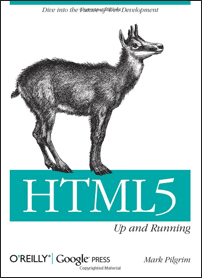Statistics on the book "HTML5: Up & Running"
 Mark Pilgrim laid out statistics on the book "HTML5: Up & Running", which was published by O'Reilly in August of 2010. Although this HTML5 reference is available for free on the Dive Into HTML5 website (licensed under the Creative Commons Attribution license), more than 14,000 copies were sold in the first six weeks (of which 25% are in digital form). Thus, O'Reilly has quickly paid for all the expenses. Now Pilgrim received his first check over what the publisher paid him in advance for the year of work on the book.
Mark Pilgrim laid out statistics on the book "HTML5: Up & Running", which was published by O'Reilly in August of 2010. Although this HTML5 reference is available for free on the Dive Into HTML5 website (licensed under the Creative Commons Attribution license), more than 14,000 copies were sold in the first six weeks (of which 25% are in digital form). Thus, O'Reilly has quickly paid for all the expenses. Now Pilgrim received his first check over what the publisher paid him in advance for the year of work on the book.Of the four written reference books, Pilgrim is only the second after Python, which has paid off to this stage. The author believes that the open publication model attracted attention to the book, thanks to which 1,500 pre-orders were received even before it appeared in stores.
Site statistics diveintohtml5.org. In 2010, it was visited by 2 million people and viewed 3.9 million pages. Each chapter of the book takes one page, because Pilgrim does not advertise on the site. Yes, he has no right to do this as an employee of Google.
40% of the traffic comes from search engines, 30% - a direct set of URLs or links to links from programs (email clients, twitter), another 30% - from 8900 referring sites.
')
98.7% of search traffic comes from Google. Less than 1% comes from Bing, the rest from search engines that Pilgrim had never suspected existed before.
The most popular chapter in the book coincides with the most popular search query. This is HTML5 video (0.5 million views, that is the eighth part of all hits on the site). Further, by a wide margin, web forms , canvas , semantics and geolocation . At the last place is Microdata .
A small section with the history of HTML was opened 250 thousand times and the average visitor spent 4 minutes on a page. More than just a section on video (4:45). Pilgrim concludes that people like online folklore.
Only 6% of visitors used Internet Explorer. Pilgrim specifically checked that all examples work fine in IE and this is not his mistake. The conclusion can be only one - Microsoft finally lost the confidence of web developers.
The site itself, its typography and interactive examples in sections of the book led to the correction of bugs in at least four browsers and one font . That's what it means to live on the cutting edge of progress, Pilgrim says.
Source: https://habr.com/ru/post/111724/
All Articles